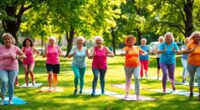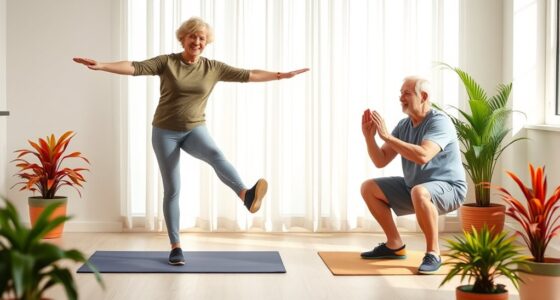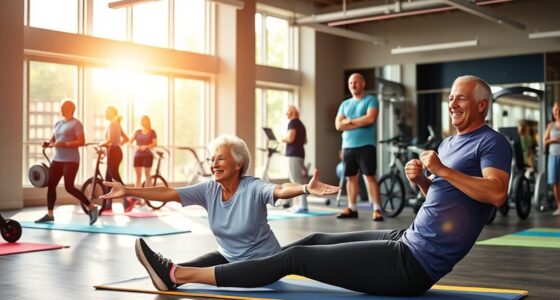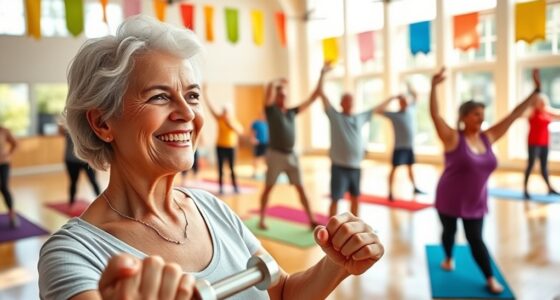Staying active as you age is essential for your health. Aim for at least 150 minutes of moderate aerobic activity weekly and include muscle-strengthening exercises twice a week. Don’t forget the importance of light activities, like slow walking or stretching throughout your day, to boost your mood and flexibility. Focus on safe exercises to enhance strength and maintain balance. Curious about the best exercises and what to avoid? There’s so much more to explore!
Key Takeaways
- Aim for at least 150 minutes of moderate aerobic activity weekly, which can be broken into shorter sessions for convenience.
- Incorporate muscle-strengthening exercises two or more days a week to enhance strength, balance, and reduce fall risk.
- Engage in regular balance exercises to improve stability and prevent falls, essential for maintaining independence.
- Light activities, such as walking or household chores, can significantly contribute to health and well-being, promoting mobility and reducing chronic disease risks.
- Avoid high-impact exercises that may lead to injuries; focus on low-impact, safe alternatives to stay active and healthy.
Physical Activity Guidelines for Older Adults
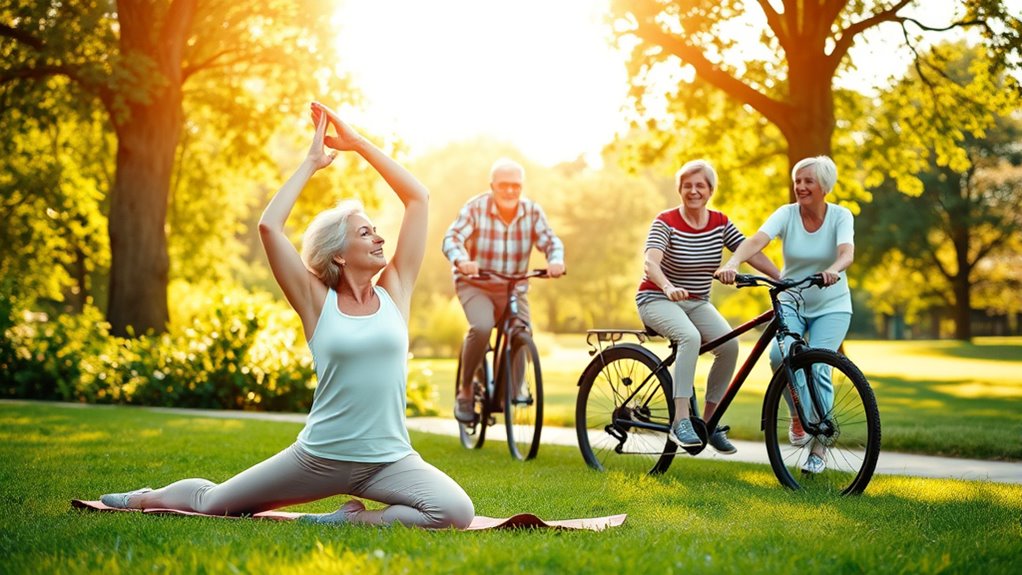
As you age, staying active becomes essential for maintaining your health and well-being.
The physical activity guidelines for older adults recommend at least 150 minutes of moderate aerobic activity each week. You can break this down into smaller sessions of 10-15 minutes, making it easier to fit into your daily routine. Incorporating healthy breakfasts can provide the necessary energy and nutrients to support your active lifestyle. Regular exercise can also help strengthen your muscle mass, which is crucial as you age. Engaging in activities that promote balance exercises can further enhance your stability and overall fitness. It’s also important to consider sustainable fashion choices that allow for comfortable movement while maintaining style.
In addition to aerobic activity, aim for muscle-strengthening activities on two or more days a week to preserve muscle mass and bone density.
Don’t forget to include balance exercises regularly to reduce your risk of falls, a significant concern as you get older.
Always consult your healthcare provider before starting any new exercise regimen, especially if you have pre-existing health conditions.
Your health is worth the effort! Regular check-ups can also help monitor your overall health and ensure you stay on track with your fitness goals.
The Importance of Light Activity
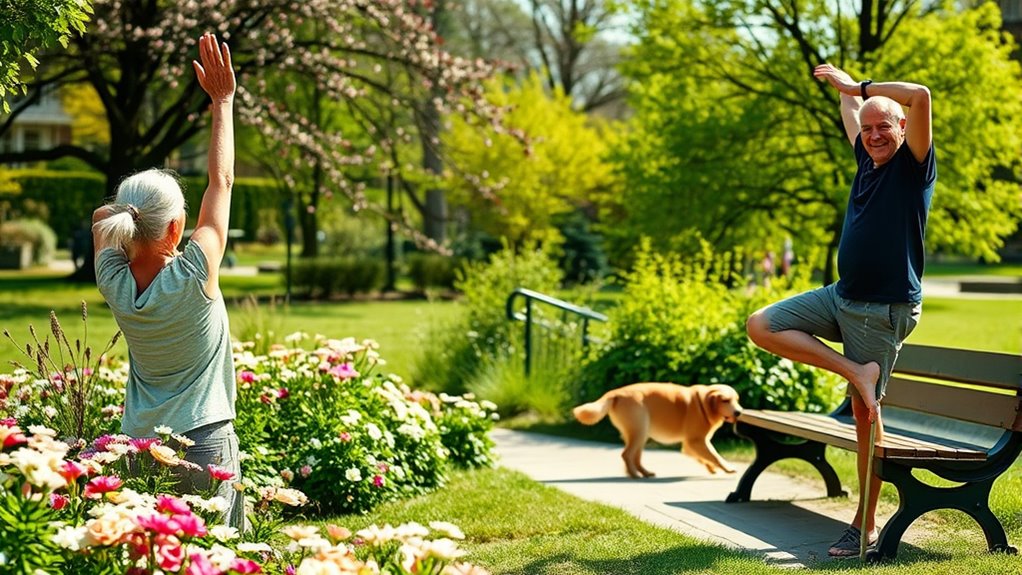
Light activity plays an essential role in your overall health as you age. Simple movements like walking slowly or doing household chores can help reduce chronic disease risks and boost your mood. Additionally, engaging in light activities can promote physical activity and mobility, which is crucial for maintaining independence and enhancing quality of life. Regular participation in light activities can also support emotional and psychological growth, which is important for maintaining mental health as you age. Moreover, listening to classical music while engaging in light activities can enhance cognitive function and improve overall mood. Engaging in juice cleansing as part of a balanced approach to diet can also support your overall wellness and energy levels.
Benefits of Light Activity
Engaging in light activity is essential for your overall health, especially as you age. Activities like making a cup of tea or walking slowly can greatly boost your mood and energy levels, enhancing your mental health. Regular light activity helps improve flexibility and mobility, making daily tasks easier and promoting your independence. By incorporating more light activities into your routine, you can effectively reduce sedentary behavior, which is linked to various chronic diseases in older adults. Even small amounts of light activity throughout the day can accumulate, contributing to the recommended 150 minutes of moderate activity per week. Additionally, incorporating visualization techniques can help you stay motivated and focused on your activity goals. Engaging in gentle stretching before light activities can also help relax your muscles and enhance overall comfort. Prioritizing light activity not only supports your physical well-being but also enriches your quality of life as you grow older. Furthermore, engaging in mindfulness practices can further enhance your mental clarity and emotional stability throughout the day. Additionally, light activity can help protect energy in chaos by providing a structured way to manage daily stressors. This proactive approach aligns with the Mental Wellbeing Index, allowing you to assess and enhance your overall mental health status.
Examples of Light Movements
There are countless ways to incorporate light movements into your daily routine, making it easier to stay active and healthy as you age. Simple activities like making a cup of tea, slow walking, or cleaning can greatly enhance your health and wellness. Engaging in these activities can also foster connections with others, similar to how texting humor helps alleviate feelings of isolation in seniors. Additionally, starting your day with a nutritious breakfast, such as Egg Rollup and Dumpling Sauce, can provide the energy needed for these light activities.
These light activities not only improve circulation but also reduce stiffness, helping you feel more comfortable in your body. By adding these movements, you can gradually reach the recommended 150 minutes of moderate activity each week. Furthermore, incorporating curiosity-driven learning can enhance your motivation to stay active and explore new activities.
In addition, engaging in light activity boosts energy levels, allowing you to tackle independent daily tasks with ease. Regularly participating in these movements can help maintain a healthy weight and decrease the risk of chronic diseases, supporting your overall well-being. Moreover, incorporating gentle methods from various parenting resources can also promote positive emotional health as you age. It is essential to recognize that open communication about feelings can greatly benefit emotional well-being during this stage of life.
Incorporating Light Activities Daily
Incorporating light activities into your daily routine is essential for maintaining your health and well-being as you age. Simple movements like making a cup of tea or walking around the house can greatly boost your overall health.
For older adults, engaging in light activity daily not only improves mood but also reduces fatigue. These incremental activities can accumulate, leading to a reduced risk of heart disease and stroke.
Additionally, by incorporating light movements, you can enhance your mobility and maintain greater independence in daily tasks. Remember to break up long periods of sitting with light activity to alleviate stiffness and promote better joint health. Regular light activity can also support financial considerations for elderly care, making it easier to manage health-related expenses.
Every little bit counts toward a healthier, more active lifestyle!
Understanding Moderate Intensity Activity

When you engage in moderate intensity activity, you’ll notice your heart rate and breathing quicken, yet you can still hold a conversation—just not sing.
This type of exercise is essential for older adults, as it enhances overall health and physical well-being. Aim for at least 150 minutes of moderate intensity aerobic activity each week to improve cardiovascular health and reduce disease risk.
Brisk walking, water aerobics, leisurely cycling, and dancing are great examples that can be adjusted to your fitness level.
Engaging in Vigorous Intensity Activity
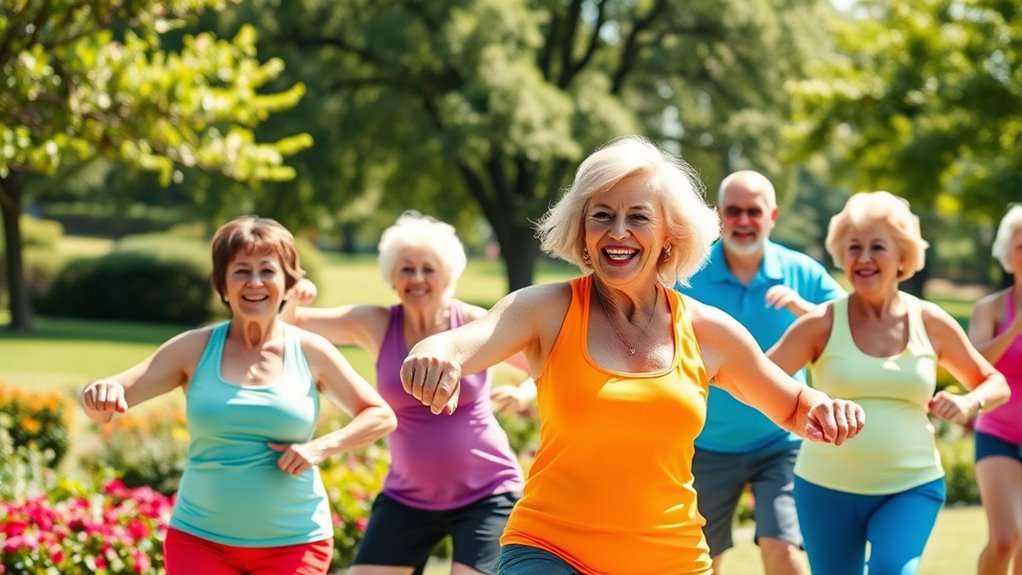
Moderate intensity activity lays a solid foundation, but adding vigorous intensity workouts can take your fitness to the next level. Engaging in at least 75 minutes of vigorous intensity activity weekly can greatly improve your cardiovascular fitness and overall health.
Here are some key benefits:
- Comparable health benefits to 150 minutes of moderate activity
- Efficient use of your time in your exercise regimen
- Increased heart rate and breathing for better fitness levels
- Adaptable workouts based on individual capabilities
- Examples include running, swimming, cycling fast, and high-intensity aerobics
Before diving in, consult with a healthcare provider to verify you can safely incorporate vigorous activities, especially if you have existing health concerns.
Embrace the challenge and enjoy the rewards!
Muscle-Strengthening Activities for Seniors
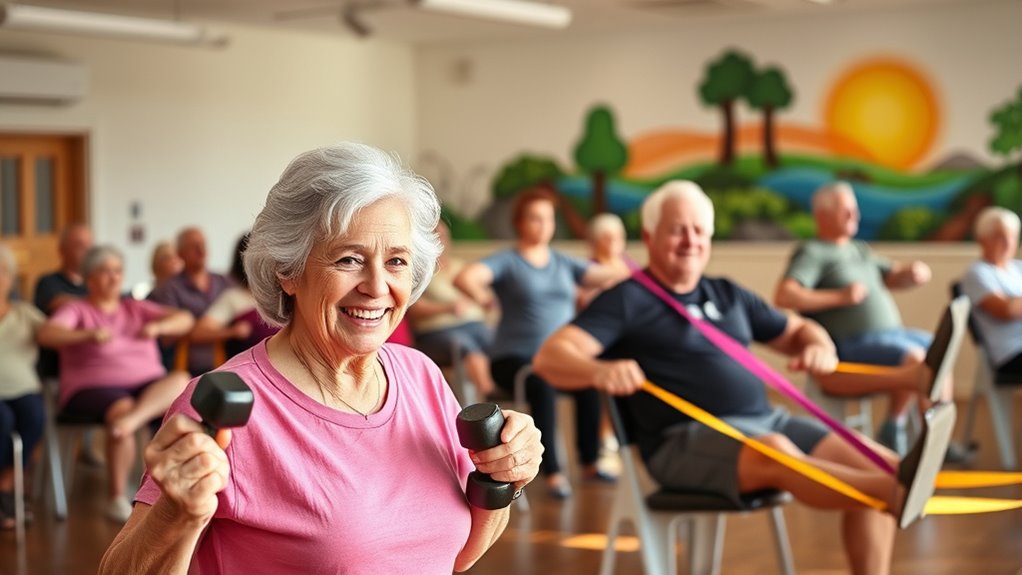
Strength training is essential for you as it helps maintain muscle mass and reduces the risk of falls.
You can safely engage in various exercises at home, using your body weight or simple equipment like resistance bands.
Incorporating activities such as wall push-ups and yoga can enhance your strength, flexibility, and balance, leading to better overall health.
Importance of Strength Training
As you age, maintaining your physical health becomes increasingly important, and incorporating strength training into your routine can make a notable difference. Here’s why you should consider it:
- Prevents muscle and bone mass loss, vital for combating osteoporosis.
- Engaging in activities at least twice a week can improve strength and balance.
- Strength training reduces fall risk by enhancing stability and coordination.
- Resistance exercises promote joint health and flexibility, making daily tasks easier.
- Regular participation can boost cognitive health, markedly lowering the risk of dementia.
Safe Exercise Options
Incorporating safe exercise options is key to maximizing the benefits of strength training for older adults. Aim for muscle-strengthening activities at least twice a week, targeting major muscle groups to maintain muscle mass and combat osteoporosis.
You can choose low-impact forms of exercise, like carrying heavy grocery bags, yoga, or Pilates, which enhance your physical functionality. Body-weight exercises, such as push-ups and sit-ups, work well too.
Make certain you have short rest periods between repetitions to keep your workouts challenging yet safe. Engaging in these activities not only strengthens your muscles but also helps reduce the risk of falls and improves balance.
Prioritizing safe exercise options is essential in managing health conditions and promoting overall well-being.
Recommended Activities and Techniques
When it comes to maintaining strength and health as you age, participating in a variety of muscle-strengthening activities can make a significant difference.
These exercises should be performed at least two days a week and can help improve your strength and overall well-being. Here are some great options:
- Weight lifting or resistance band exercises
- Yoga or Pilates for flexibility and strength
- Bodyweight movements like push-ups and squats
- Carrying heavy shopping bags to build functional strength
- Balance exercises to enhance stability
Incorporating these muscle-strengthening activities not only boosts your strength but also reduces the risk of falls, improves balance, and enhances the overall health benefits of exercise for seniors.
Don’t forget to include some aerobic activity for a well-rounded routine!
The Best Exercises for Seniors
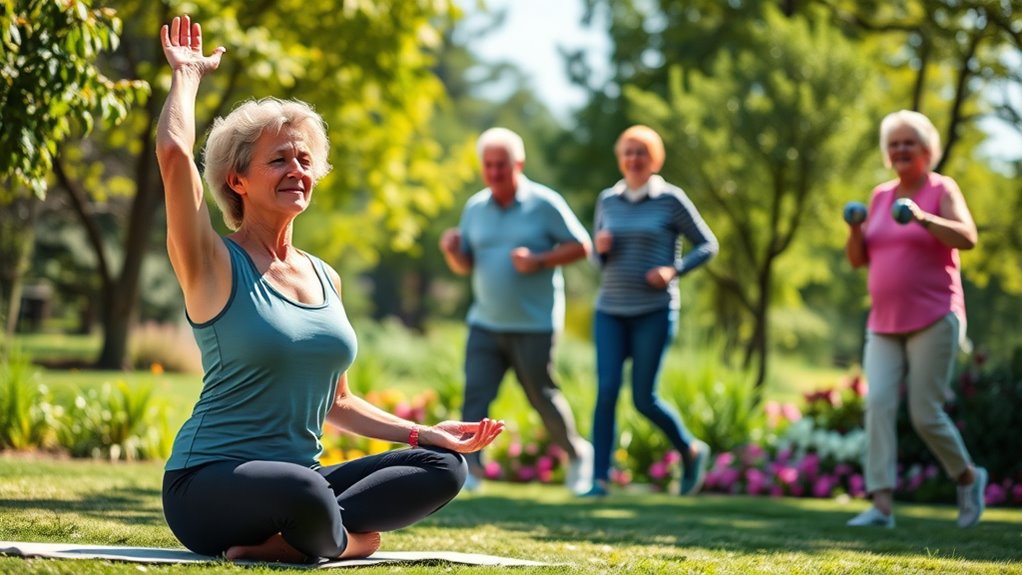
Finding the right exercises can make a notable difference in your overall well-being as a senior.
Chair yoga exercises are gentle yet effective, helping to improve balance and flexibility while reducing stress on your joints.
Water aerobics exercises provide a full-body workout with natural resistance, enhancing cardiovascular health.
Tai Chi combines gentle movements with mindfulness, notably reducing your risk of falls while also improving balance and flexibility.
Pilates focuses on core strength and alignment, which is perfect for maintaining stability as you age.
Don’t forget low-impact cycling, which offers an adaptable cardiovascular workout that promotes physical and mental well-being.
Incorporating these exercises for older adults can lead to a healthier, more active lifestyle.
Health Benefits of Regular Exercise
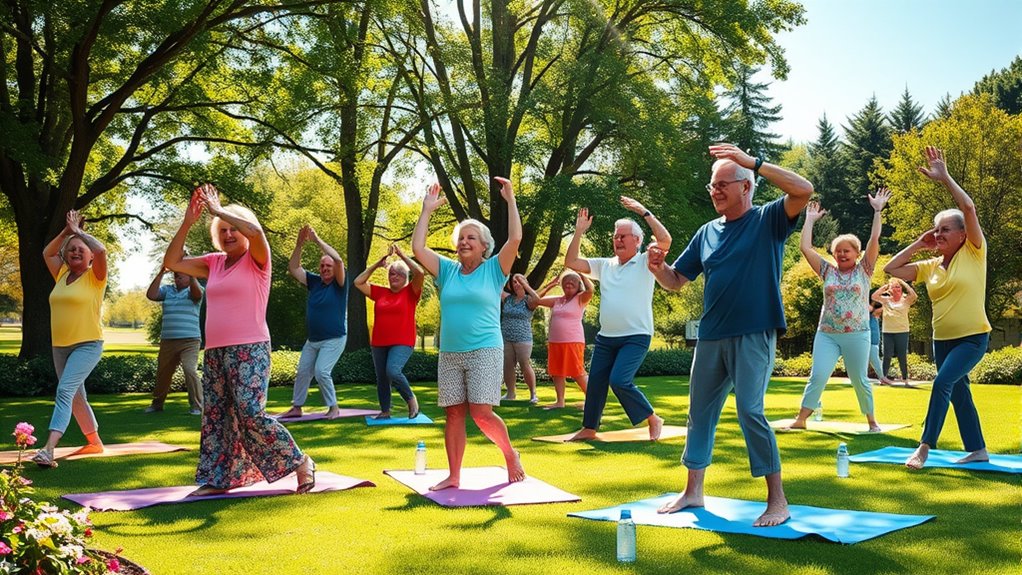
Regular exercise offers a multitude of health benefits that can greatly enhance your quality of life as you age.
By keeping an active lifestyle, you can:
- Reduce the risk of falls by up to 23%, keeping you safe from serious injuries.
- Improve muscles and bone strength, helping to prevent osteoporosis and muscle loss.
- Enhance cognitive health, decreasing the risk of Alzheimer’s and dementia by nearly 50%.
- Boost mood and sleep quality through the release of endorphins, reducing symptoms of depression.
- Maintain independence in daily activities like walking and dressing, improving overall mobility.
Embracing regular physical activity is essential for older adults to enjoy a healthier, more fulfilling life.
Regular physical activity is vital for older adults seeking a healthier, more vibrant life.
Don’t wait—start reaping these benefits today!
Exercises Seniors Should Avoid

As you age, it’s important to be mindful of the types of exercises you choose, since certain activities can lead to injuries or exacerbate existing health issues. Here are some exercises seniors should avoid due to their high-impact nature and potential risks:
| Exercise | Reason to Avoid |
|---|---|
| Running | Can worsen joint pain and injury risk |
| Leg Press | Poses spinal injury risks if done incorrectly |
| Upright Row | Can lead to shoulder injuries |
| High-Intensity Interval Training | May cause exhaustion and injury |
Frequently Asked Questions
What Type of Exercise Is Best for Older Adults?
When it comes to the best exercise for older adults, you should focus on a mix of activities that promote cardiovascular health, strength, and balance.
Aim for moderate aerobic exercises like walking or swimming for at least 150 minutes weekly.
Don’t forget muscle-strengthening exercises twice a week, and incorporate balance activities like tai chi.
Low-impact options, such as chair yoga and cycling, can also help maintain flexibility and reduce joint stress.
How Does Regular Exercise Help Older Adults Stay Healthy?
Regular exercise helps you stay healthy by maintaining muscle and bone strength, which reduces the risk of fractures.
It lowers your chances of falls and enhances cardiovascular health, preventing heart disease and diabetes.
You’ll also notice improvements in cognitive function, with a reduced risk of Alzheimer’s and dementia.
Plus, exercise boosts your mood and energy levels, markedly enhancing your overall quality of life.
Staying active truly makes a difference as you age!
Which Type of Exercise Is Most Strongly Recommended for Older Adults?
The most strongly recommended type of exercise for you is moderate-intensity aerobic activity, like brisk walking or water aerobics, aiming for at least 150 minutes weekly.
Additionally, you should incorporate muscle-strengthening exercises on two or more days each week, targeting all major muscle groups.
Balance exercises, such as tai chi, are also essential for preventing falls.
Always consult your healthcare provider to tailor your routine to your specific needs and fitness levels.
How to Keep the Elderly Active?
You might think staying active is too challenging for the elderly, but it doesn’t have to be overwhelming.
Start by incorporating short walks or light gardening into their daily routine. Encourage them to engage in simple muscle-strengthening and balance exercises a couple of times a week.
Making activities fun and social can motivate them to stay active. Most importantly, guarantee they check in with a healthcare provider to tailor the activities to their needs.
Conclusion
In the grand tapestry of life, staying active is your golden thread. Embracing exercise as an older adult isn’t just about keeping up with the Joneses; it’s your ticket to energy and independence. Whether you’re taking a leisurely stroll in the park or lifting light weights, each movement you make is a step toward better health. So, lace up your sneakers, channel your inner Hercules, and remember: it’s never too late to strengthen your body and spirit!

